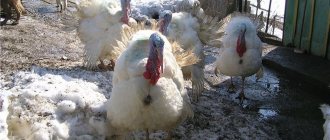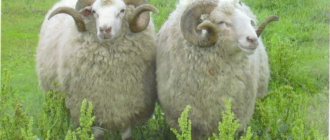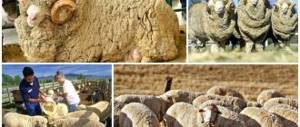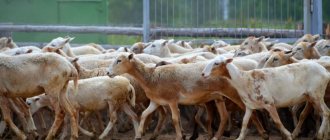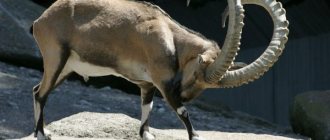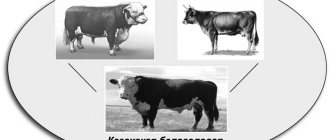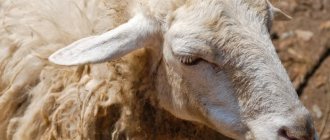Where do sheep come from?
It is difficult to talk about the specific origin of this animal, since there is no exact data on these facts. It is generally accepted that the ancestors of the domesticated sheep were European and Asian mouflons, as well as the urial, another name - the steppe sheep. After which this animal was domesticated by people, presumably 12-8 thousand years ago. Residents of Asian countries welcomed animals that are able to travel a long way with nomads. Europeans occupied sheep only on settled farms.
The Asian Mouflon is considered one of the ancestors of sheep.
Then the animals began to be crossed in order to achieve better performance in wool, meat, and milk. Therefore, there are now about 850 breeds.
Types of rams and sheep
Quite a few varieties and breeds of these animals are known. Many breeds are domesticated and bred for meat or wool . Or maybe both. For this purpose, for example, meat-haired breeds are used. Also, to obtain more sheep wool, it is better to breed long-haired types of sheep. An excellent option is the Russian long-haired breed of sheep.
The following types are also known:
- Soviet merino. It is bred primarily to produce soft merino wool.
- Karakul breed of sheep. It can be classified as a coarse-wooled breed of sheep. Carpets are made from coarse wool, and the skins are used to produce astrakhan fur coats.
- Border Leicester is well suited for both meat and wool.
- Dagestan breed of sheep - used for meat and wool production.
- Altai breed - raised for meat and wool.
These breeds are classified as domestic sheep, but many wild species of this family of animals are also known. For example, Mouflon, Bighorn sheep, also known as mountain sheep, Bighorn sheep, Argali, Urial and many others.
Description of the animal
A sheep is a domesticated form of a wild mountain sheep. The animal is similar in appearance to a goat, but differs in larger size and hair. This is a cloven-hoofed animal of the bovid family. The horns are wrapped in small spirals. Depending on the breed, some representatives lack horns, which makes them vulnerable. The wool curls into rings, but some breeds do not have this feature. Strong legs allow animals to cover long distances and navigate mountainous terrain. The size and weight of the animal will depend on the breed, the record weight of a ram reached almost 250 kg, but the average animal weighs 100-120 kg for males, 60-70 kg for females.
The weight of one variety of sheep reaches 250 kg
Rams and sheep are unpretentious to food and maintenance in general, since for a long time they lived in an area where there was practically no succulent food. The structure of their teeth allows them to eat everything right down to the root, that is, to use food completely. Breeding rams and sheep is profitable because they are hardy, have good health, and illnesses are rare in these animals. Almost all of them are not aggressive, they obey their owner, the shepherd, well. Animals tolerate cold and heat well, but are not adapted to dampness, which is why they are practically absent in countries with a tropical climate.
Sheep adapt well to weather conditions. Not picky about food
These animals are not considered to be the smartest. This happens for the reason that a herd of sheep behaves somewhat differently compared to other domesticated animals. On the pasture, they are often only interested in food and not what is happening around them; they are more focused on their own reflexes than on trying to adapt to what is happening around them. It takes them much longer to get used to a new environment or develop the simplest habit than other animals. Even in terms of anatomical structure, the brain of a domesticated sheep is inferior in size to its wild ancestors.
Another explanation for their behavior is the herd instinct. The most comfortable state for these animals is a large herd. When completely alone, the animal experiences extreme stress. Being in a herd, they completely turn off logic and simply move behind their brothers, so once they stray from the herd, it is difficult for them to return.
Animal Reproduction
Animals in their natural environment reach sexual maturity at approximately two to three years of age .
Domesticated individuals mature much earlier, and are allowed to mate after reaching one and a half years. After mating occurs, the rams leave the female, which is fertilized, and go in search of another sheep.
Gestation of lambs in sheep lasts approximately five months .
When the female feels the imminent appearance of lambs, she leaves her herd for a while and goes to a secluded place, where the babies will be born. A newborn lamb is born weighing approximately 3 to 5 kilograms . Therefore, a sheep can have one or two babies in one litter. At a more mature age, a ewe can give birth to three lambs. After birth, the babies spend a few more days in the shelter, and then come back to the herd with the sheep.
Babies feed on mother's milk until they are three to four months old. Although already from a month they can eat plant foods as well. And after six months the lambs become completely strong.
Differences between sheep and rams
A ram and a sheep are one and the same thing, if we consider the concepts in a narrow sense. A ram is a male sheep, that is, the same representative of this species of animal, only male. But despite this, they have their own distinctive features.
The main sign by which sheep can be distinguished from rams is the size of the animal.
The first difference that helps to distinguish a ram and a sheep is the size and weight of the animal. The male is almost 1.5 times larger than the female. Typically, if a representative of a certain breed weighs 100 kg, then a female of the same breed reaches only 60-65 kg. The difference also lies in the presence of horns. There are breeds of sheep, some have horns, others do not, and there are also breeds where only rams have horns. Another answer to the question what is the difference between a ram and a sheep, the ability to produce milk, rams do not have this ability. Differences are visible between males and females during the breeding season, when breeding rams fight for the right to own a female, while such behavior is not noticed among females.
Which lamb tastes better?
The difference between sheep and rams also exists from a culinary point of view: not only between females and males of domestic meat, meat-wool, meat-and-milk or fat-tailed (meat-cutting) breeds, but also between domestic lamb and game (if hunting is allowed).
How to prepare for slaughter
Lamb has a specific smell in general: this applies to carcasses of any gender and age. By frying over a fire or pre-marinating, or adding a large amount of aromatic spices, the unpleasant odor is partially neutralized.
But for the lamb to be perfect, the owner must take care of the successful sale of the “controversial” meat long before slaughter.
Domestic sheep live up to 12 years, but their most productive age is 7-8 years. At the same time, the meat of males and females slaughtered before the age of 1.5 years is valued.
Be sure to read:
Sheep of the Gissar breed: photos and videos, cultivation, maintenance, breeding
Sheep ribs grow throughout their lives, and in older animals there is virtually no meat between them, which reduces the nutritional value of the carcass. The “venerable” age of lamb (over 3 years) is evidenced by loose fat of a yellowish color with a sharp, specific aroma. Lamb meat has a lighter red hue than meat from adult animals.
The meat of females is softer and more tender, because the fat layer in it is larger than that of males, although the fat tail (fat near the tail) is more noticeable in the latter. This may be due to the fact that the weight of males is approximately 2 times that of females.
The fat sac is clearly visible in sheep of the fat-tailed breed. The taste and smell of fat tail fat depends on the pasture grass and soil: fat in the tail fat accumulates during periods of heavy feeding.
Sheep prefer herbs with sour and sweet tastes, if local conditions allow. A fat tail bag is a kind of strategic reserve, like a camel’s hump, and therefore the smell of fat depends, among other things, on the grass on which the animals grazed.
True connoisseurs of kebabs and pilaf claim that without fat tail fat these dishes lose their taste. Lamb fat, in general, determines the taste of meat. Taking into account this feature, it is necessary to take care of the “tasty diet” of sheep 2-3 months before slaughter.
If the owner keeps sheep for wool or milk, and it is unprofitable to slaughter sheep for lamb meat, then at least to improve the taste of the meat:
- It is mandatory to castrate breeding males 3-4 months before slaughter;
- Females are slaughtered no earlier than 3 weeks after estrus;
- Pregnant sheep are not slaughtered;
- It is advisable to transfer culled animals to stall housing 1-2 months before slaughter, increasing the succulent feed in the diet;
- Stop feeding one day before: an accidentally damaged intestine or bladder will spoil the smell of meat;
- A slaughtered carcass must be hung to drain the blood; Meat aging should take place in a cool room.
Sheep are shy animals, and stress causes the accumulation of specific hormones in the blood and tissues, which change the smell of lamb at the tissue level at the time of slaughter.
Be sure to read:
Raising sheep as a profitable business: advice for a beginner, maintenance and breeding
Therefore, they need to be slaughtered quickly, in a place isolated from other sheep, without causing alarm signals.
It is for this reason that wild sheep meat has a sharper odor and denser texture: the wild animal experiences prolonged stress during the chase.
How to choose lamb
All of the above must be taken into account when choosing lamb on the market.
Additionally, in order not to fall for the cunning tricks of an unscrupulous seller, you should remember:
- Lamb has a specific culinary property: there is no pungent odor immediately after slaughter (about 24 hours), over the next 48-72 hours it increases and then almost disappears; therefore, it is better to prepare dishes either from fresh meat, or to keep it for 2-3 days, but not to freeze it.
- Red or blue veins, spots on the flesh indicate that the animal was improperly slaughtered or was exposed to stress before slaughter, which means that the dish will have a pronounced characteristic odor;
- Ribs that are too wide - old lamb, tough meat;
- The freshness of lamb is determined by pressing: the elastic flesh quickly levels out;
- After pressing with a finger, there should be no traces of water left in the dent, which indicate that the meat was frozen, as well as blood, which indicates improper slaughter;
- Between sheep and ram, it is preferable to choose lamb meat: it is much lighter and more tender, and the bones are white;
- A reliable way to check quality: burn a piece of fat, and if you can only smell the meat, then the lamb will not spoil the dish.
However, do not despair if a mistake was made when choosing meat. The smell will disappear when soaked in water or milk.
For first courses, you can put a piece of lamb in cold water, add garlic, peeled carrots, onions, bay leaves, bring to a boil, then drain the water and rinse the meat. Soaking lamb in vodka or other strong alcoholic drinks helps to cope with the problem.
Breeding animals as a business
Breeding sheep has long been a profitable business; with the right approach, the farmer makes good money from these animals. The main advantage is that almost all products can be sold. All products are valued on the market, from meat to wool. Every year the owner receives several kilograms of wool from the animal, and if there are more than a dozen animals in the herd, the profit naturally increases. Ewes are able to give birth 3 times within two years, each time with several lambs, which makes it possible to increase the number of livestock in a short time.
Increasing the number of herds
The meat and fat of these animals is nutritious, tender, and has its own unique taste, which makes it possible to sell it at high prices. Some breeds are more valuable. Sheep provide milk, which makes excellent cheese. Even the animal's skin is sold.
Sheep lambing
It is necessary to prepare a special room for childbirth in advance. It must be clean and heated. It is recommended to cover the floor with straw. The female is placed separately from the rest of the individuals.
These signs will help determine the onset of labor:
- restless behavior of the female;
- swelling of the udder;
- redness of the genitals;
- sagging belly.
The birthing process in a sheep lasts about 6 hours. As a rule, the animal copes with this on its own without human help. However, the farmer needs to monitor the birth of lambs; emergency assistance may be required.
To keep sheep, you will need to study a lot of literature and take advice from experienced farmers. Sheep farming takes a lot of effort and time. However, hard work will be rewarded with quality products.
What is the name of lamb meat?
And finally, it should also be clarified what sheep meat is called, because this question also involves its own nuances. The generally accepted name for meat products obtained from the slaughter of sheep is “lamb”. This is the word used to designate meat of this category on the market.
But a more specific approach to the issue involves dividing all sheep meat into two separate categories:
- Lamb. This concept refers to meat products obtained from one-year-old sheep.
- Mutton. Lamb is the meat of animals that are more than one year old.
Reference. Among lovers of such meat products, lamb is valued much higher. It is believed that the pulp of one-year-old lambs contains significantly more beneficial properties. In addition, the taste of this meat is richer, and the flesh itself has a delicate consistency. Naturally, the difference is reflected in the cost of each type of meat product.
Thus, the concepts of sheep and ram are correlated depending on the context that stands behind each of the concepts. In a broad sense, these are different units of classification of species of animals of the bovid family. A narrower meaning implies that these terms refer to the female and male individuals within the same species of domestic animal. In the second case, there is a clear series of signs by which, taking into account the characteristics of the breed, one can easily distinguish a ram from a sheep.
